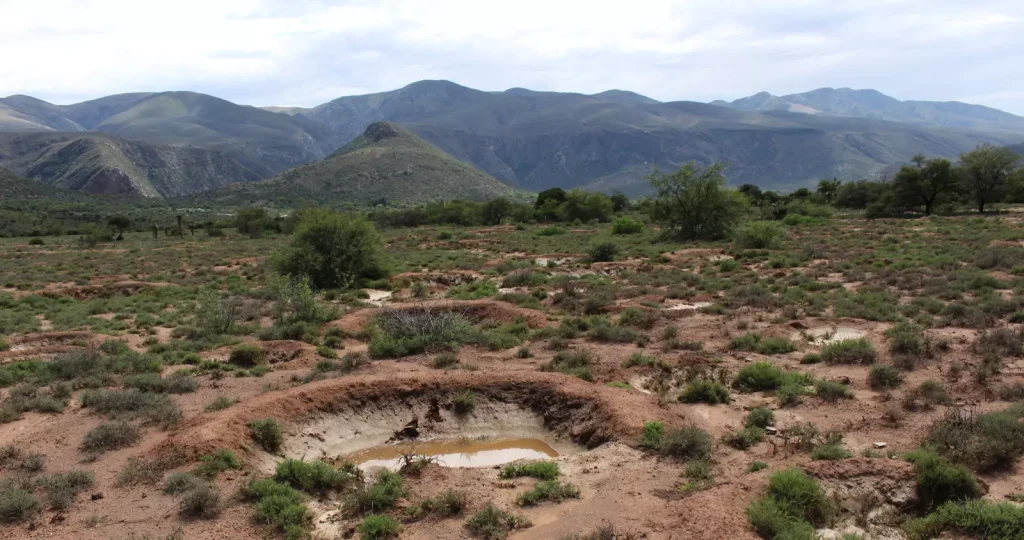This impact story was originally posted by the World Economic Forum here.
- The World Economic Forum’s Global Risks Report identifies 10 interrelated risks facing humanity in the next decade.
- Landscape degradation is central to these risks as both a catalyst and cause of human-induced climate change and natural disasters.
- Tackling landscape degradation through integrated landscape restoration provides an opportunity to address interconnected global risks.
Over the last century, we’ve degraded 75% of the world’s habitable land. At current trends, 90% will be degraded by 2050. Unsustainable land use and farming practices are the main causes of this degradation, eroding soils, triggering food and water shortages, destroying biodiversity and releasing carbon. And agriculture produces one-third of global greenhouse gas emissions.
Landscape degradation lies at the heart of the environmental, social and economic risks identified in the recent World Economic Forum’s Global Risks Report. As landscapes degrade, natural resources deplete, economies fail and conflict and forced migration abound. There is abundant evidence for the link between environmental destruction and social and economic unravelling – 40% of all intrastate conflicts over the last 60 years have been linked to natural resources.
Scientific models forecast that more than 143 million people in three regions – sub-Saharan Africa, South Asia and Latin America – may become climate migrants by 2050. And it’s estimated that land degradation currently threatens 50% of the global gross domestic product (GDP).
But there is hope. As it’s at the heart of the world’s most pressing challenges, tackling landscape degradation provides a huge opportunity to address multiple interconnected global risks. For too long, environmental, social and economic risks have been dealt with in silos. Integrated landscape restoration – the large-scale, long-term restoration of degraded ecosystems through community-driven approaches – can help us eradicate these silos and holistically tackle global risks. Let’s explore how.
Mitigating climate and environmental risks
Landscape degradation exacerbates and causes climate change and environmental disasters on a local and global scale. One example is water. Too much or too little water is often the greatest problem facing local communities. Just as the risk of flooding worldwide increases – predicted to impact 221 million people and result in $ 1.7 trillion yearly by 2050 – so does the risk of large-scale droughts, with even Europe now on the verge of a water crisis.
The blame for these risks usually falls on climate change and extreme weather events. But research suggests land-use changes in water catchment areas – like deforestation, intensive agriculture and wetland drainage – are the underlying reasons for flooding and droughts.
Landscape restoration can reduce water-related – and other environmental – risks by protecting and restoring natural ecosystems, making them more resilient to and mitigative of climate change effects. Wetland and forest restoration, for example, are cost-effective approaches that generate at least 28% more added value than built infrastructure, like flood barriers, dams and storm drainage systems.
Natural infrastructure creates multiple benefits, such as air pollution reduction, carbon capture, natural habitat conservation (including species migration), and soil restoration. That protects people from risks and promotes the ecological functioning of the landscapes we all depend on.
Supporting thriving local and global economies
Just as degraded land destroys GDP, healthy landscapes provide a foundation for economic prosperity and food and water security. Integrated landscape restoration places nature and people at the heart of socioeconomic recovery and growth. Thriving natural ecosystems support thriving local economies, providing a stable source of income for communities and preventing rural-urban migration.
Through creating a shared landscape restoration plan, local stakeholders can upskill, strategize and implement integrated land management practices – like rewilding and regenerative agriculture – that protect the natural ecosystem and support local people with resilient production areas in the long term. In this way, integrated approaches to landscape restoration bolster local economies, ensuring that the natural resources they need to survive and do business flourish well into the future.
We see examples of this all over the world. Entrepreneurs in Southern Spain, for instance, are combining forces to restore an area of 1,000,000 hectares over 20 years, aiming to revitalize rural populations, create biodiversity corridors and combat desertification.
Cross-sector and multi-level collaboration to tackle interrelated risks
A long-term landscape approach promotes action far more than a single project or sector approach can, cutting across institutional boundaries and policies and national borders. Just look at the Great Green Wall Initiative, a Pan-African tree planting initiative that stretches 8,000 km, covering 780 million hectares across 11 countries.
At the same time, integrated landscape restoration is led by local people, making it more effective in the long term. Landscapes are where communities live and work; by working at the landscape level – across scales of at least 100,000 hectares – we can directly impact communities.
When actors from farming, policy, business, finance and conservation come together in multi-stakeholder partnerships, it encourages trust between groups. In this way, integrated landscape restoration stimulates cross-sector partnerships and breaks down economic, political and social silos: which is critical for addressing complex risks.
Addressing the root causes of global risks
Restoring landscapes via an integrated approach can help us dig away at the root causes of the world’s risks to the benefit of people and the planet. Through rebuilding natural ecosystems and enhancing local and, in turn, societal resilience, we can work together to create a truly sustainable world for future generations.
But rolling out integrated landscape restoration at the scale needed requires collective action and an economic shift. Moving away from short-term, (often) project-based aid funding towards long-term funding is essential to produce meaningful change.
We stand at a crossroads. Along one path, we continue “business as usual,” fully aware that it leads to a more perilous future. Along the other, we take global action to develop resilience to the interconnected risks presented in the Forum’s Global Risk Report 2023, using integrated landscape restoration, among other solutions, to create a positive impact within people’s lifetimes today.
